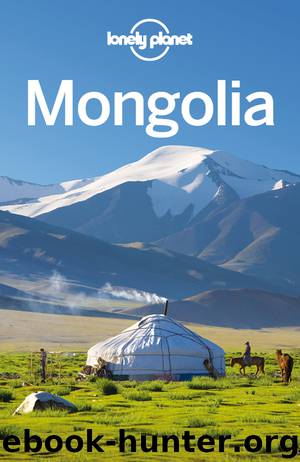Mongolia Travel Guide by Lonely Planet

Author:Lonely Planet
Language: eng
Format: epub
Publisher: Lonely Planet
History
The Tamtsagbulag Neolithic site in Dornod, active more than 4000 years ago, is proof that agriculture predated nomadic pastoralism on the eastern steppes. But it was the Kitan, a Manchurian tribal confederation, who made the first big impression on the region, building forts and farming communities in the 10th century, including Kherlen Bar Khot in Dornod.
Another Manchu tribe, the Jurchen, deposed the Kitan in the early 12th century, renamed itself the Jin, and returned eastern Mongolia to its warring ways. It wasn’t until Chinggis Khaan united the fractured clans in 1206 that peace took over.
It was from Avarga (modern Delgerkhaan) that Chinggis launched expeditions south towards China. When the capital was moved to Karakorum in 1220, the region withdrew into obscurity. It wasn’t until 1939 that eastern Mongolia was again in the headlines, this time as a battlefield between Japanese and joint Soviet–Mongolian forces. Heavy losses forced the Japanese military machine south, a crucial turning point in WWII.
The discovery of zinc and oil in the region in the 1990s brought the promise of development, with change hot on its heels. These natural resources have altered the local landscape, with oil wells and other mining infrastructure now a permanent fixture of the Dornod landscape.
Climate
Eastern Mongolia’s climate and landscape have more in common with northeastern China than with Central Asia. Temperature extremes are less severe and winds less violent than in the west. While the Khan Khentii Mountains get a lot of rain in the summer, annual precipitation on the steppes is about 250mm. Winter daytime temperatures fall to -20°C but skies are usually blue.
Getting There & Away
A paved road connects Ulaanbaatar and Chinggis Khot and work is ongoing to take it to Baruun-Urt. The road to Choibalsan is also under construction. Both should be finished within the lifetime of this book. Other towns and attractions are connected by decent dirt or dirt and gravel roads, often boggy after heavy rains.
Buses for Chinggis Khot, Baruun-Urt and Choibalsan depart from Ulaanbaatar’s Bayanzürkh Avto Vaksal bus station (Click here). Private vehicles wait at the Naran Tuul (Click here) jeep station. Another route into the region is through northern Khentii – daily minivans from Naran Tuul travel to Dadal via Ömnödelger and Binder (these are not well advertised so you may need a local to help you contact the drivers).
Getting Around
Public transport can get you to most towns in the region provided you’re armed with the patience of an angel. But if you want to see what the region really has to offer you’ll need your own transport.
Download
This site does not store any files on its server. We only index and link to content provided by other sites. Please contact the content providers to delete copyright contents if any and email us, we'll remove relevant links or contents immediately.
China Rich Girlfriend by Kwan Kevin(3896)
The Silk Roads by Peter Frankopan(3763)
Annapurna by Maurice Herzog(2842)
Hot Thai Kitchen by Pailin Chongchitnant(2813)
Full Circle by Michael Palin(2773)
Okonomiyaki: Japanese Comfort Food by Saito Yoshio(2391)
City of Djinns: a year in Delhi by William Dalrymple(2136)
The Ogre by Doug Scott(2115)
Photographic Guide to the Birds of Indonesia by Strange Morten;(2089)
Tokyo by Rob Goss(2018)
Vietnam, Cambodia, Laos & Northern Thailand by Lonely Planet(2014)
Tokyo Geek's Guide: Manga, Anime, Gaming, Cosplay, Toys, Idols & More - The Ultimate Guide to Japan's Otaku Culture by Simone Gianni(1947)
Discover China Travel Guide by Lonely Planet(1866)
Everest the Cruel Way by Joe Tasker(1827)
China (Lonely Planet, 11th Edition)(1798)
Lonely Planet China(1755)
China Travel Guide by Lonely Planet(1741)
Top 10 Dubai and Abu Dhabi by DK Travel(1717)
Iranian Rappers And Persian Porn by Maslin Jamie(1710)
